How to Create a Keras-Style Neural Network from Scratch
 Chinmay Pandya
Chinmay Pandya
Deep learning, leveraging multi-layered neural networks, has gained popularity due to enhanced computational power and large datasets. It excels in image and speech recognition, NLP, autonomous driving, and healthcare diagnostics, transforming industries by automating complex tasks and enabling high-accuracy data analysis and decision-making.
Creating a neural network from scratch can significantly deepen your understanding of how modern deep learning frameworks like Keras operate. This guide will walk you through the theoretical aspects of building a neural network, covering layers, activation functions, loss functions, and optimization techniques.
Neurons
Neurons in neural networks are computational units that mimic biological neurons.
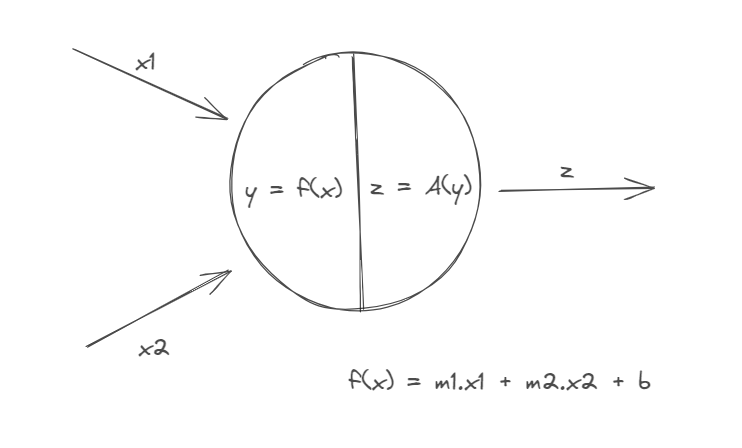
Each neuron calculates own weight (m1, m2) for each input (x1, x2). They receive input, apply a weighted sum, add a bias, and pass the result (y) through an activation function. Activation functions tell whether a neuron is "on" / "off".
This is a single neuron, when organized in layers, they create a neural network.
Chain rule
Let's look at this simple example

The steps which take place are as follows
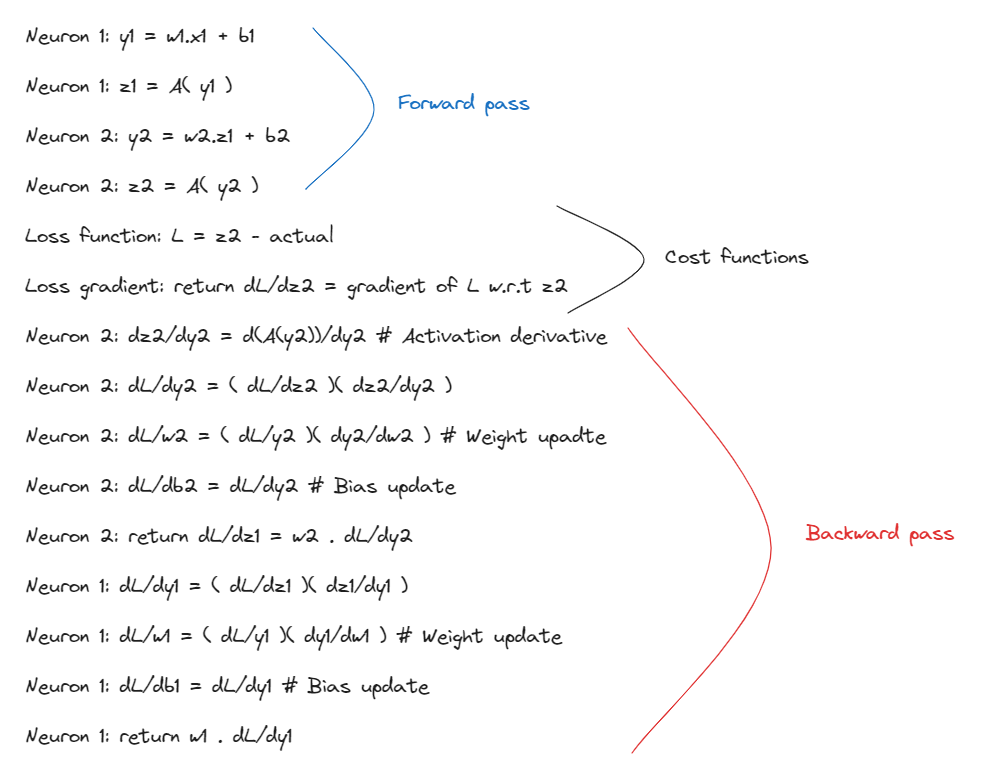
However this computation is clubbed together to form a chain

Thus the final output or the prediction is just a chained operation of the selected output and activation functions.
Dense Neural Network
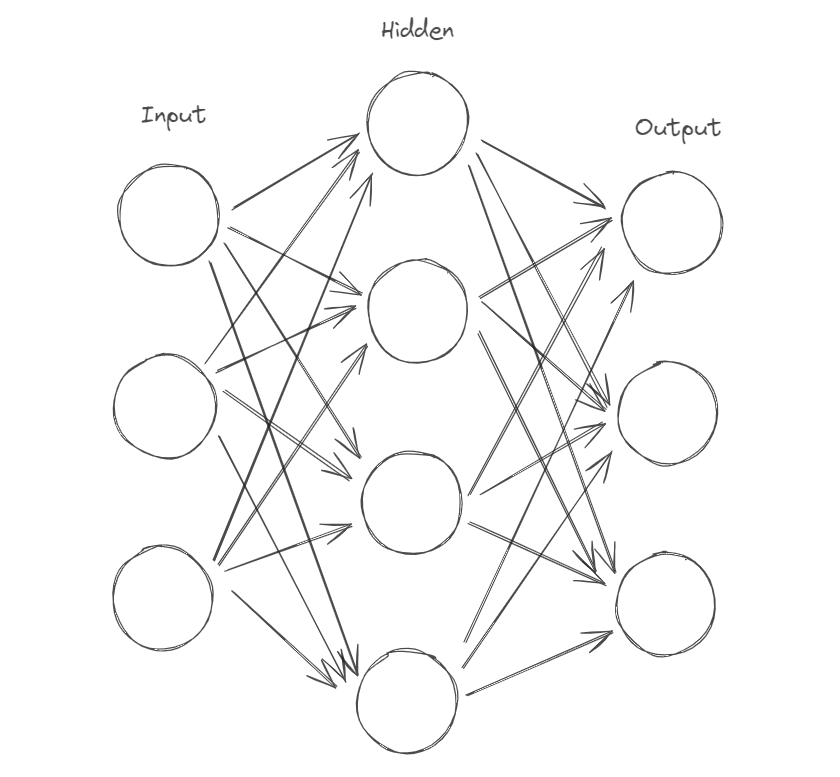
This is called a "Dense" layer where every neuron is connected to every neuron of the succeeding layer. Some famous libraries used to create a neural network are Keras, Tensorflow, Pytorch, etc.
Previously we saw that neuron computes y = w.x + c. But here we have 4 neurons. so the output of the layer will not be a single value but a row [ y1, y2, y3, y4 ]. And if we have multiple input samples ( input rows ), each y will itself be a row of values for each sample. Therefore, the output of a layer will be a matrix.
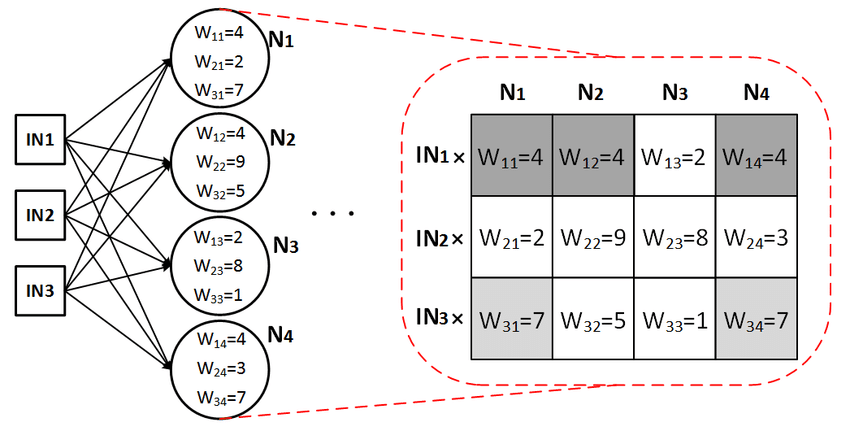
Notice how a matrix represents an entire layer. In the picture, the matrix holds values for different neurons in different columns. You can also use the transpose to get each neuron in different rows instead of columns; either way works.
On studying a simple 1x1 neural network, we saw with the chain rule how many computations take place. However, this structure, even though it looks complex, is not hard to implement. We only need to create and update two matrices (for two layers) once in each epoch. Let's create this from scratch using just numpy.
Building from Scratch
import numpy as np
import pandas as pd # only for data saving/extracting purposes
We will use the principles of Object Oriented Programming using Python to create classes and objects for layers and neural networks.
Layer
class Layer:
def __init__(self, output_size, input_size, activation="none"):
self.weights = np.random.rand(output_size, input_size)
self.bias = np.random.rand(output_size, 1)
self.__activation = Activation(activation)
def activate(self, X):
return self.__activation.activate(X)
def activation_derivative(self):
return self.__activation.activate_derivative(self.output)
You can see that I have defined a Layer class which will be inherited by sub classes to create "Dense" or "Sparse" layers. Since each layer has its activation function, we need to implement activation class for dynamic activations.
Activation function
class Activation:
def __init__(self, func):
self.__func = func
def activate(self, X):
if self.__func == "relu":
return np.maximum(0, X)
elif self.__func == "softmax":
exp_values = np.exp(X - np.max(X, axis=1, keepdims=True))
return exp_values / np.sum(exp_values, axis=1, keepdims=True)
else:
return X
# calculates gradient for activation
def activate_derivative(self, X):
if self.__func == "relu":
return np.where(X > 0, 1, 0)
elif self.__func == "softmax":
return X
else: # no activation
return np.ones_like(X)
Now let's create a dense layer
Dense Layer
class Dense(Layer):
def __init__(self,output_size, input_size, activation="none"):
Layer.__init__(self, output_size, input_size, activation)
def forward_pass(self, data):
self.input = np.array(data)
y = np.dot(self.weights, self.input) + self.bias
self.output = self.activate(y) # -- activation
# self.output = y # -- no activation
return self.output
def backward_pass(self, loss_gradient, learning_rate):
activation_gradient = self.activation_derivative()
# dl/da -- gradient for activation
output_gradient = loss_gradient * activation_gradient
# dl/dy -- gradient for output
weights_gradient = np.dot(output_gradient, self.input.T)
# dl/dw -- gradient for weights
self.weights -= learning_rate * weights_gradient
self.bias -= learning_rate * np.sum(output_gradient, axis=1, keepdims=True)
input_gradient = np.dot(self.weights.T, output_gradient)
# transforming gradient for next layer
return input_gradient
Sequential Network
class Sequential:
def __init__(self):
self.__layers = []
def add(self, layer):
self.__layers.append(layer)
def forward_pass(self, data):
output = data
for layer in self.__layers:
output = layer.forward_pass(output)
return output
def backward_pass(self, loss_gradient, learning_rate):
for layer in reversed(self.__layers):
loss_gradient = layer.backward_pass(loss_gradient, learning_rate)
def compile_(self, loss):
self.__loss = loss
def fit(self, X, Y, epochs, learning_rate):
X = np.array(X)
Y = np.array(Y)
for epoch in range(1,epochs+1):
output = self.forward_pass(X)
loss_gradient = self.__loss.gradient(output, Y)
self.backward_pass(loss_gradient, learning_rate)
loss_value = self.__loss.calculate(output, Y)
#print at every 100th epoch
if epoch % 100 == 0:
print(f"Epoch {epoch}/{epochs}, Loss: {loss_value}")
def predict(self, X):
X = np.array(X)
pred = self.forward_pass(X.T)
res = np.mean(pred, axis=0)
return [round(i) for i in res]
# only for simplicity
def coef(self):
return self.__layers[-1].weights, self.__layers[-1].bias
We also require a "Loss" class for calculating cost and gradient.
Loss
class Loss:
def calculate(self, output, y):
raise NotImplementedError
def gradient(self, output, y):
raise NotImplementedError
This is a general class which can be inherited by different sub class like MSE, CrossEntropy, etc.
class MSE(Loss):
def calculate(self, output, Y):
n_samples = output.shape[1]
loss = np.mean(np.mean((output - Y)**2 / 2, axis=1))
return loss
def gradient(self, output, Y):
n_samples = output.shape[1]
loss_gradient = (output - Y)/n_samples
return loss_gradient
Data
def generate_random_samples(n_samples, a, b):
# Generating random values for the first three columns
return np.random.randint(a, b, size=(n_samples, 3))
random_samples = generate_random_samples(10000, 0, 100)
data = pd.DataFrame(random_samples, columns=['x','y','z'])
data['target'] = data['x'] + 2 * data['y'] + 3 * data['z']
# generated 10,000 rows of data where the target is calculated as:
# target = x + 2y + 3z
# you can save this to a file to avoid recalculation
data.to_csv('data/numbers.csv', index = False)
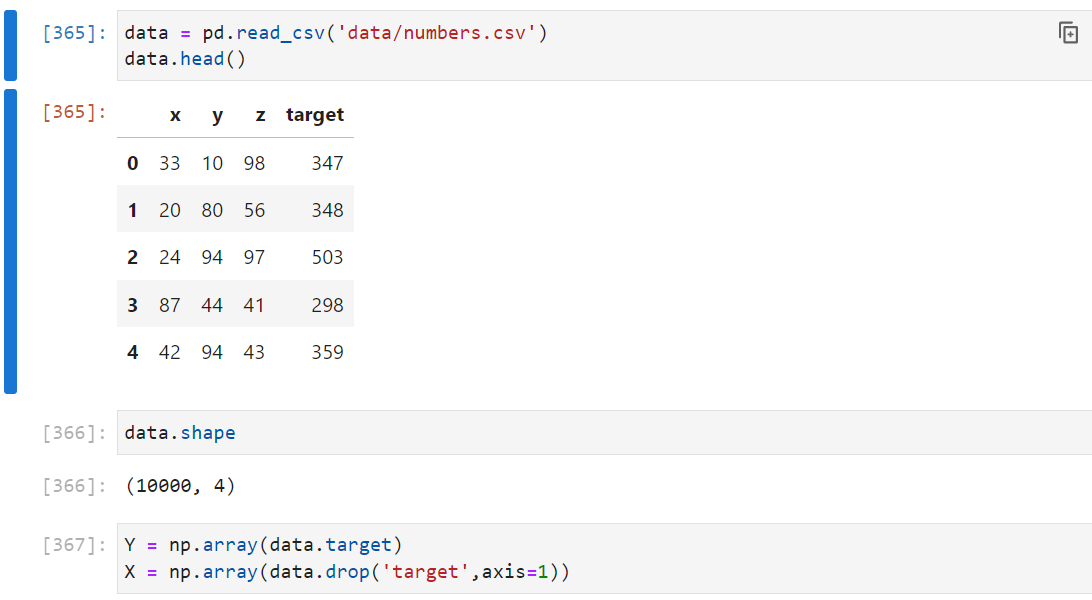
Train Test
Y = np.array(data.target)
X = np.array(data.drop('target',axis=1))
# for simplicity
X_train, X_test, Y_train, Y_test = X[:9000], X[9000:], Y[:9000], Y[9000:]
Model
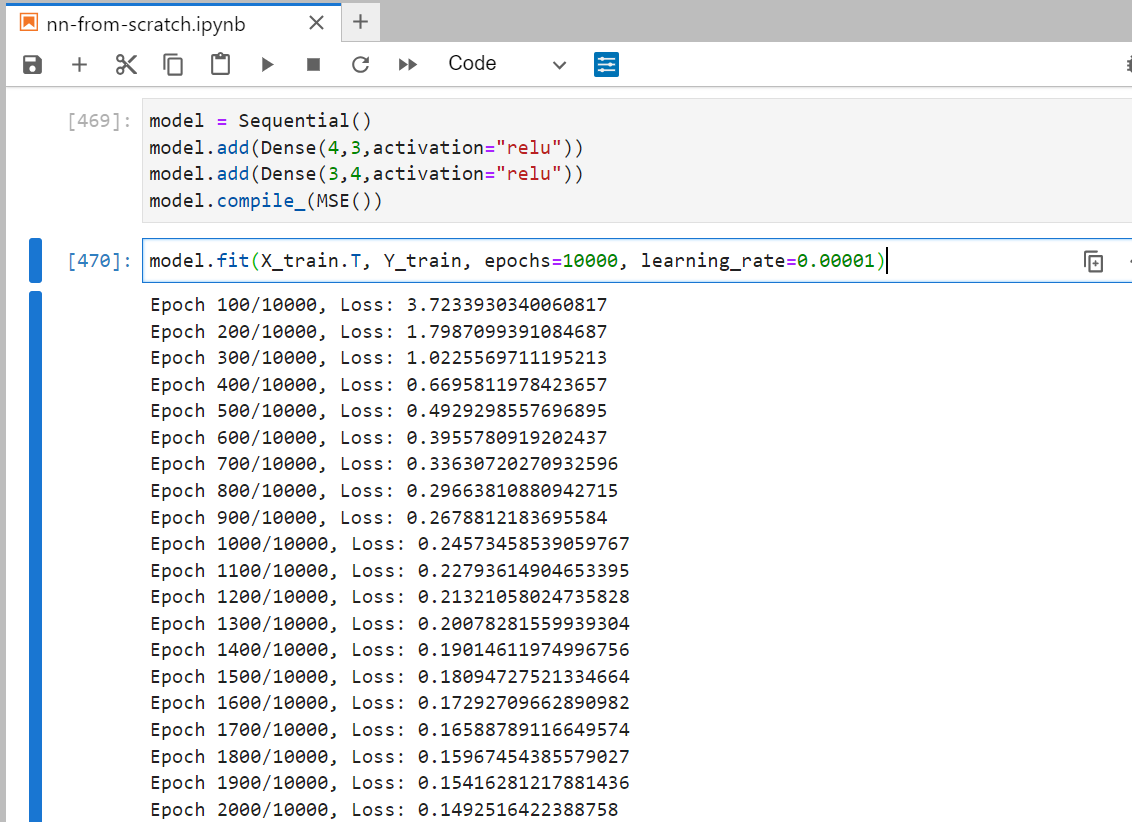
I have added two dense layers with 4 and 3 neurons respectively.
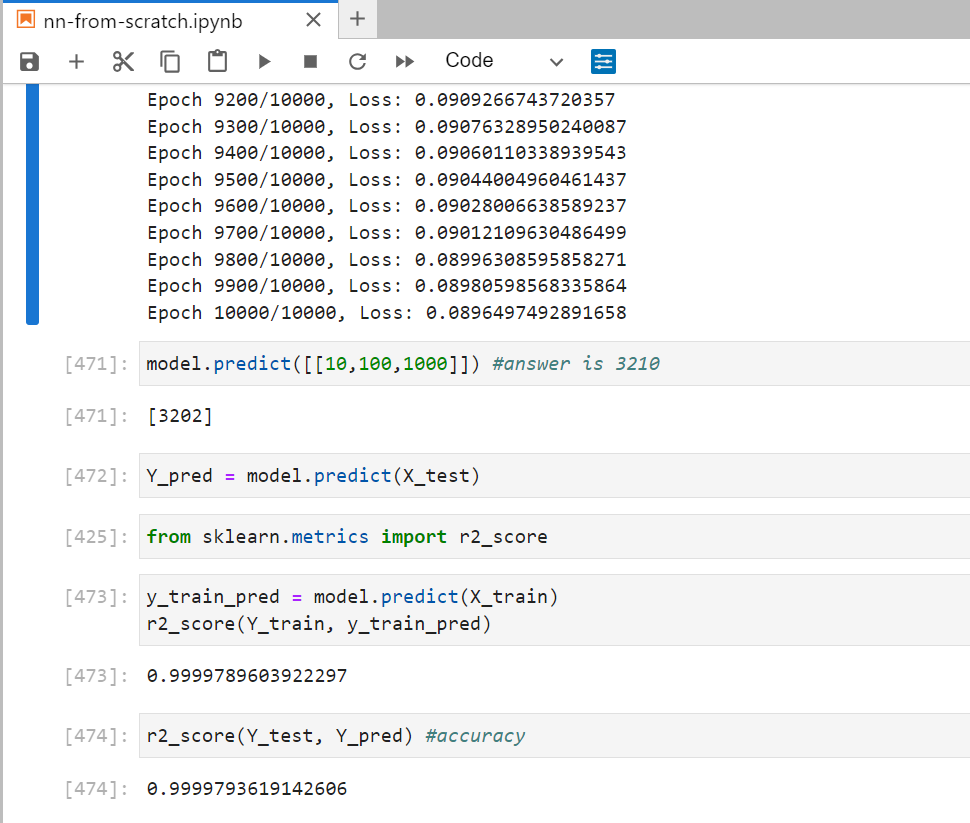
Super Easy!
More models
Let's create a simple 1 layer model comprising 3 neurons and see if it correctly adjusts weights and bias.
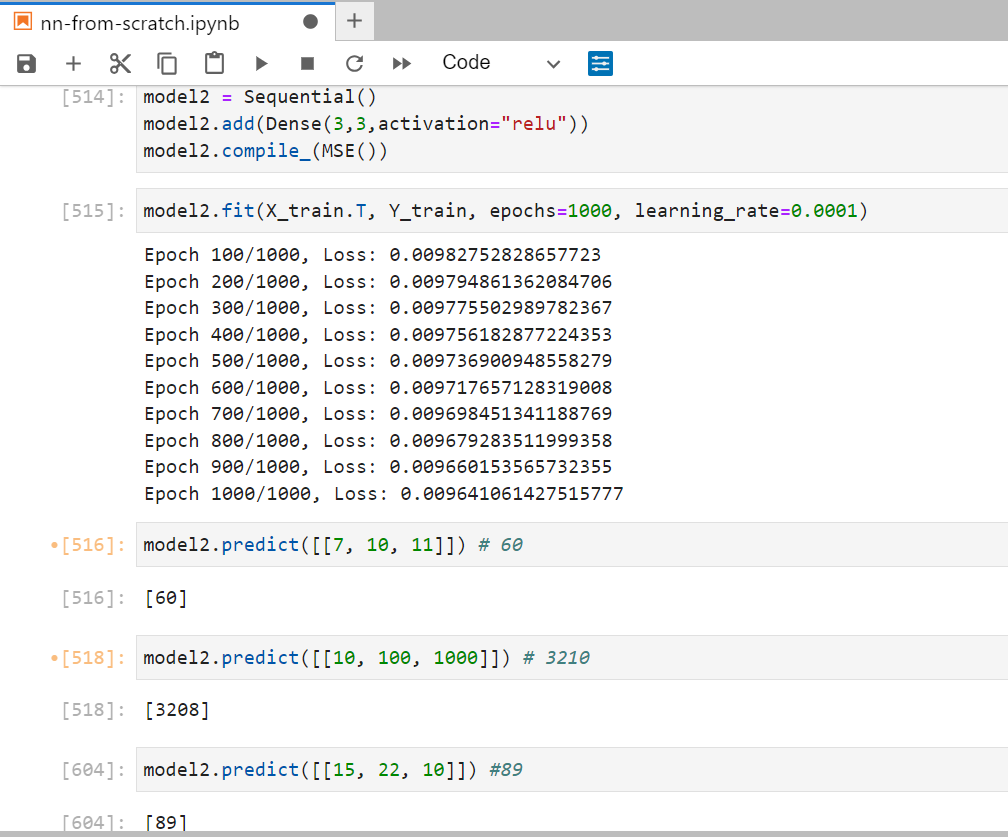
Model 2 needs fewer epochs and a higher learning rate because it is less complex than the previous one. You can try creating your own model based on your understanding and experiment with the parameters to find the optimal values. In the end, it's all about "Trial and Error".
Coefficients
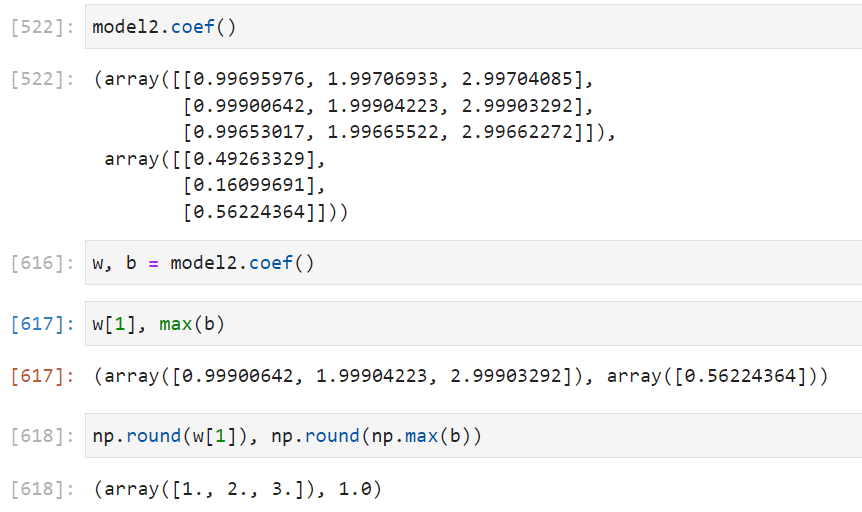
Notice that the three neurons in the output layer have weights close to 1, 2, and 3, which are our actual weights. The biases are 0.49, 0.16, and 0.56, while our bias is 1.
In a more complex neural network, the coefficients are not calculated the same way. This is because multiple layers contribute to the output, so the weights are cumulative.
Activation significance
We know that our maximum bias is 0.56, which is the closest to the actual value among the three. Therefore, after backpropagation, this specific neuron and the preceding neurons that contribute to this outcome will become more active. This means the value after activation will get higher or "brighter". For neurons that are farther from the actual value, they will get "dimmer", meaning their output after activation will be even lower.
A high activation means that the neuron is more closer to the truth. Look at this example.

This is a complex dense neural network with 3 hidden layers. For each neuron, the whiter it gets, the more "active" it is, and therefore, the more "relevant" it is. The leftmost neurons are the input features. The black ones indicate that these features are the least important or "irrelevant," while the white ones are the most important features.
Validate
Let's see if our model is generalized and works on higher numerical values
from sklearn.metrics import r2_score
# 100 samples between 5000 and 10000
test_samples = generate_random_samples(100, 5000, 10000)
m = np.array([1, 2, 3])
y_high_test = np.sum(test_samples * m, axis=1)

Save the model
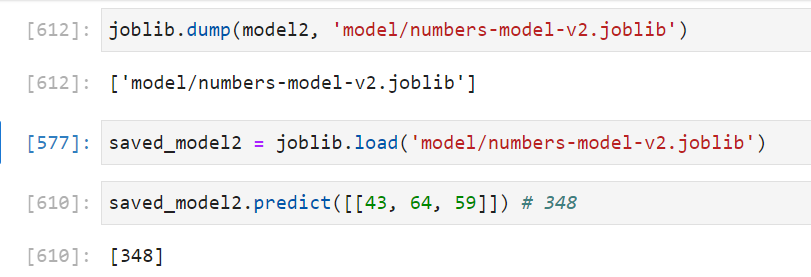
Github
The entire code is available on my Github repository. Follow the link:
Conclusion
We successfully created a Keras-style neural network for regression by understanding the chain rule and using OOP with Numpy and Python. This helped us gain a deeper understanding of how deep neural networks compute outputs.
Thanks for reading it through! I hope you liked it. Feel free to like and comment any doubt or suggestion regarding any topic. You can also reach out to me on my social in my bio. I am open to discussion :)
Subscribe to my newsletter
Read articles from Chinmay Pandya directly inside your inbox. Subscribe to the newsletter, and don't miss out.
Written by

Chinmay Pandya
Chinmay Pandya
👨💻 About Me: Hii, I'm Chinmay, a passionate and organized computer science student dedicated to lifelong learning and content creation. My journey in technology began with a curiosity-driven exploration of software development, cloud computing, and data science. 🌟 Blog Story: Driven by a desire to share knowledge and inspire others, I founded Hashnode, a platform where I chronicle my experiences, insights, and discoveries in the world of technology. Through my blog, I aim to empower fellow learners and enthusiasts by providing practical tutorials, thought-provoking articles, and engaging discussions. 🚀 Vision and Mission: My vision is to foster a vibrant community of tech enthusiasts who are eager to learn, collaborate, and innovate. I am committed to demystifying complex concepts, promoting best practices, and showcasing the limitless possibilities of software development, cloud technologies, and data science. 🌐 Connect with Me: Join me on this exciting journey of exploration and growth! Follow Me for valuable resources, tutorials, and discussions on software development, cloud computing, and data science. Let's bridge the gap between theory and practice and embrace the transformative power of technology together.